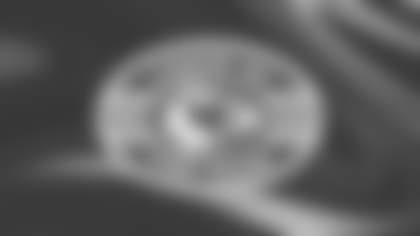Anybody who's taken the time to know anything about Chiefs founder Lamar Hunt knows that he was about as far from a meddling team owner as you can find today. Today's owners meddle – if that's the right word for someone who as owner has every right to do as he chooses – all the time in trades and player moves. Think Jerry Jones, who does hold the title of GM, of course, or Washington's Dan Snyder. Even Bud Adams, late of Houston, now of Tennessee, reportedly pushed for the drafting of Texas quarterback Vince Young from the University of Texas.
So, Lamar Hunt was different. But once, just once, Hunt became involved in a trade and following that one occasion, he quickly stepped back from that role, maybe because he believed he could never top it.
The year was 1962 and Hunt's Dallas Texans were engaged in a battle for the hearts and minds of Dallas fans with the NFL's Dallas Cowboys. The Texans had more than their share of Texas-bred players, including a quarterback by the name of Cotton Davidson, a classic pulled-from-the-pages-of-fiction name if there ever was one.
It was during the early days of the American Football League, a league Hunt had founded and, as such, he believed it was his task to look at the big picture, not just what was in the best interests of his franchise, or so the legend goes.
The Texans had managed to compile a .500 record in the first two years of their existence. Head coach Hank Stram got the notion of signing Len Dawson, a player who he had coached at Purdue University earlier in his career and who had recently been released by the NFL's Cleveland Browns. (These things happened back then, too, sports fans, so don't act surprised like they are of recent vintage.)
Well thought of when he came out of college and drafted by the NFL, Dawson's talents had declined probably as much from under-use as anything else. Indeed, he admitted as much. Still, Stram knew him and believed he could be the catalyst to take his team to the next level.
Enter Hunt, who as legend would have it, believed the Oakland Raiders, a franchise barely surviving, needed a new quarterback. Hunt, as league founder, believed the existence and well-being of the league was no small matter and his responsibility in a way was to see it survive.
So, with the season already in play, Hunt sent Davidson to Oakland in exchange for the Raiders number-one draft choice and the negotiation rights to LSU's Fred Miller. The trade, in the media's eyes at the time, was seen as the team's "biggest…ever [after only two years not a big deal, really] and if it doesn't explode in their face, it could be their best," said one writer.
But it was not without risk. Indeed, according to the Dallas Morning News, Texans management "confessed their necks are now stretched in monumental vulnerability." Admitted Texans GM Jack Steadman: "It's a gamble. Trades are always a gamble, especially after the season has started."
Printed reports at the time revealed that trade talks had been in play for a while and that Hunt, who "had apparently supervised the swap, not necessarily with the encouragement of his advisers," had initially turned down a chance to get all-league center (and future Hall of Famer) Jim Otto, described by league scribes as "one of the few assets on the Raiders payroll."
That deal would have cost the Texans not only Davidson but their center, Jon Gilliam, admitted Steadman. "We looked at Otto's play…compared to Gilliam's and didn't feel there was that much difference. If we could have got Otto for Davidson and kept Gilliam, we probably would have traded that way. But pro clubs have always gone high for No. 1 draft choices. We feel that Oakland's first choice amounts to the league's first choice."
With the loss of Davidson, however, the Texans also found themselves without a punter, no small matter. Davidson was one of the best in the league. And while he hadn't helped lead the Texans to a championship, he was considered one of the better signal-callers in the AFL, too, having come off the bench and led an AFL all-star team the year before to a victory. In the trade, he received a new no-cut contract and assurances from the Raiders that he was the starter. Moreover, his pay was elevated $20,000 or $4 G's more than he had been paid by Dallas. Still, the move necessitated his departure from his native Texas. "This is my home," he said when being told of the trade. "I work here for the Lee Company. I have a ranch near here. I know I'm being traded for two players who aren't even signed, but that's football. It's hard to know what they're thinking."
Ah, the matter of signing the two draft choices. One turned out to be Buck Buchanan, so looking back on it now, the trade appeared to be a smashing success. As for Miller, a 240-pound tackle, he had been drafted as a future by the Raiders the year before and was touted to be among the Top-50 prospects in the country.
But in the short term, it was Dawson and his performance that made the trade a success. He had been a gamble and the team's backup, rookie Eddie Wilson, was hardly a household name. In the long run, however, it was Buchanan who provided the push to a championship that encompassed both leagues. The Texans, eventually Chiefs, were to become one of the great defensive teams of their era and Buchanan was one of the initial building blocks of that unit.
Much as it is today, the team reacted quickly to public scrutiny of the trade and any possible downside. "Dawson is our number-one quarterback," Steadman pronounced, "and the only thing that would change that is for him to get hurt. Pro teams take that risk every year. Who's behind [Johnny] Unitas? Who's behind Milt Plum?"
Well, Dawson didn't get hurt and retired 12 years later becoming a member of the Pro Football Hall of Fame in 1987. As for Davidson, he played a total of six seasons for Oakland but whose career as a starter was already in decline by 1963. And Miller? He opted for the Baltimore Colts, who had selected him in the seventh round of the 1962 draft, where he had a long (10 years) if undistinguished career, or as far as I could determine.













